This four-image mosaic comprises images taken from a distance of 27.9 km from the centre of Comet 67P/Churyumov-Gerasimenko on 12 January. The image resolution is 2.4 m/pixel and the individual 1024 x 1024 frames measure 2.4 km across. The mosaic is slightly cropped and measures 4.4 x 3.9 km.
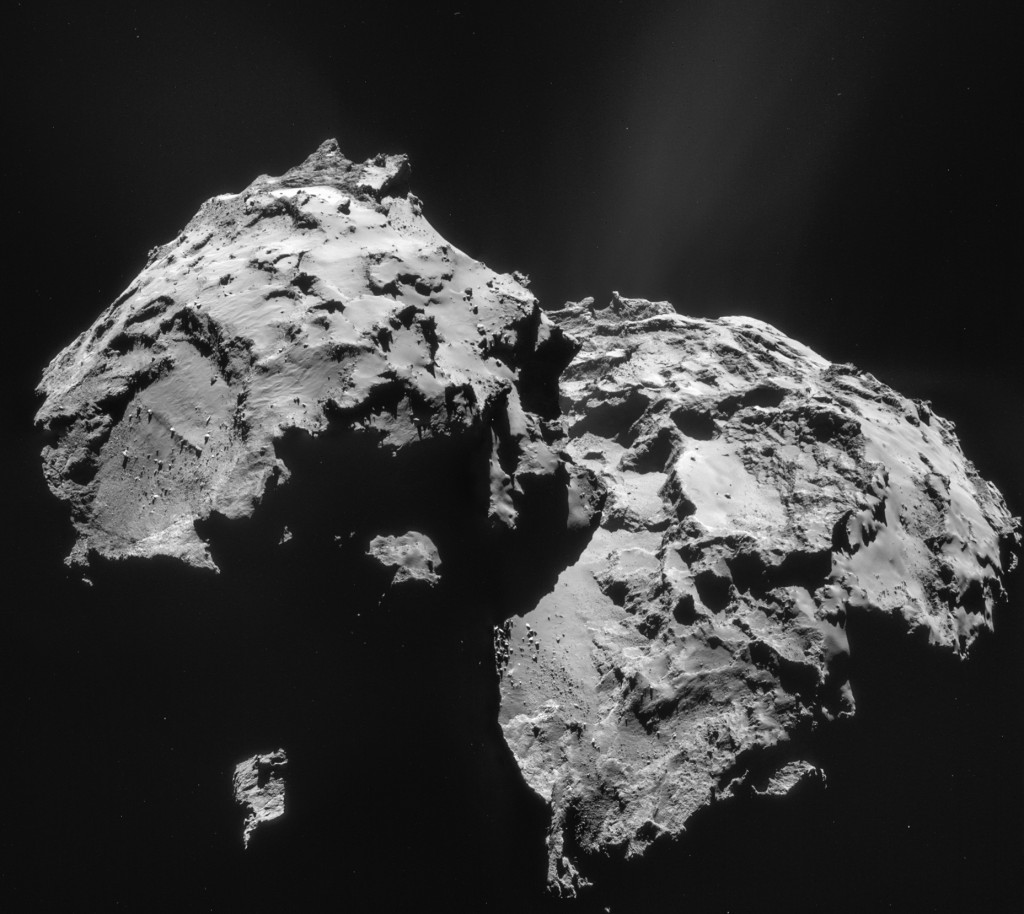
Four image mosaic comprising images taken on 12 January 2015 by Rosetta’s Navigation Camera (NAVCAM). Rotation and translation of the comet during the imaging sequence make it difficult to create an accurate mosaic, and there may be some spurious spatial and intensity features as a result of the mosaic-making sequence, so always refer to the individual frames before performing any detailed comparison or drawing conclusions about any strange structures or low intensity extended emission. Credits: ESA/Rosetta/NAVCAM – CC BY-SA IGO 3.0
This view is complementary to the 8 January CometWatch, with the comet’s smaller lobe in the foreground, but this time on the left. The new view provides a side-on look onto the large and roughly circular depression close to the Agilkia site, but this time from the opposite side, revealing parts of the cavity that were hidden from sight in the 8 January image.
The larger of the two comet’s lobe fills the right half of the image. While the light effect is less dramatic than in the 8 January image due to a different orientation of the shadows, the new view perhaps allows a better comparison between different surface features. Indeed, the view incorporates the smooth surface along the comet’s neck, itself covered in dust and boulders, to pitted terrains interspersed with smoother patches, boulders and cliffs.
The four individual 1024 x 1024 frames, along with a montage of the frames, are provided below:

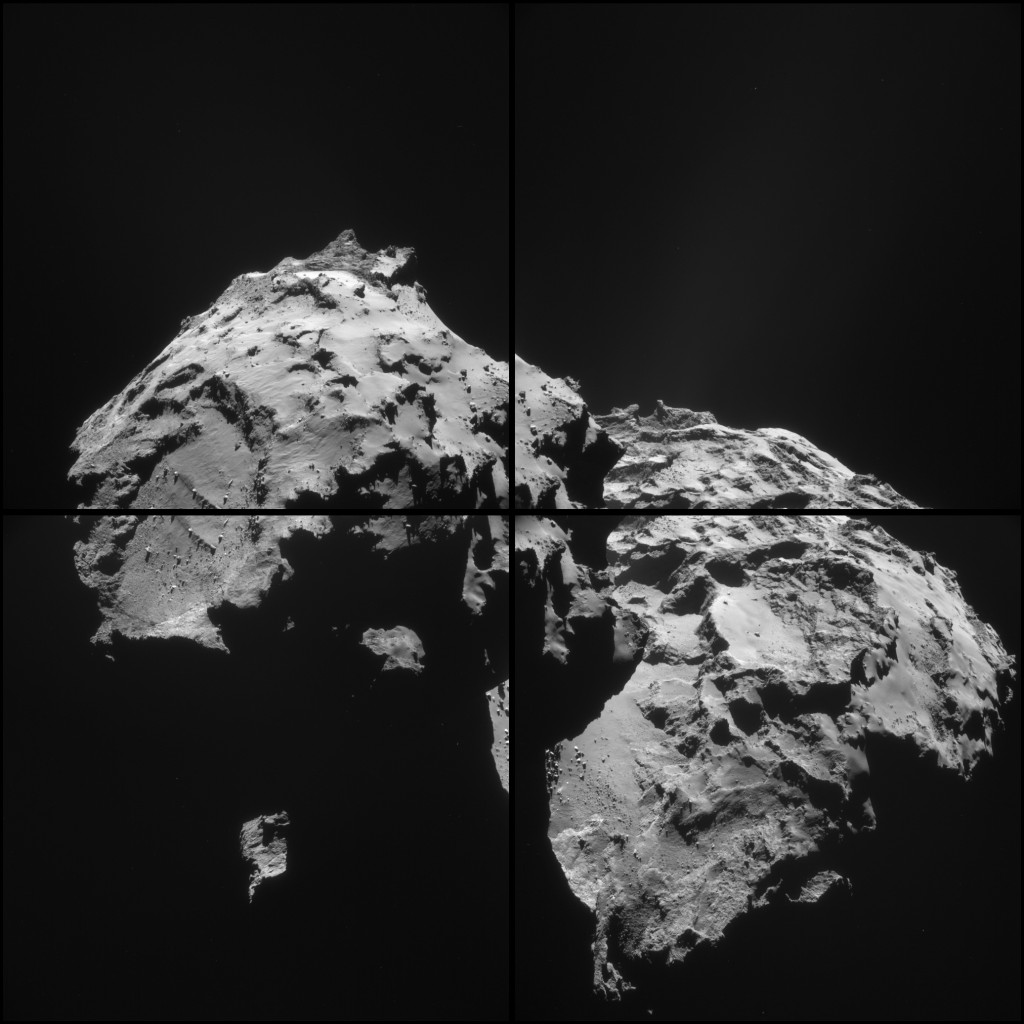
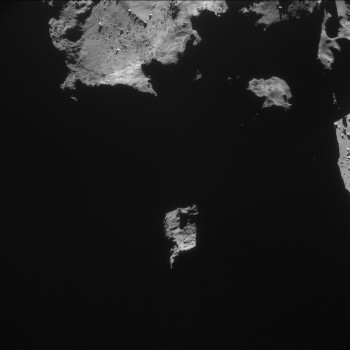
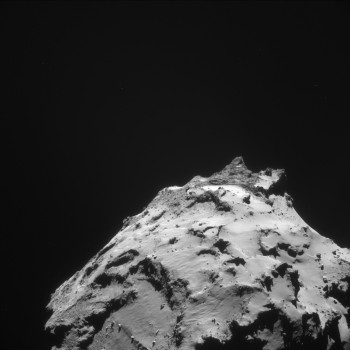
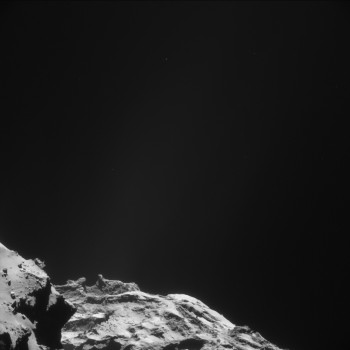
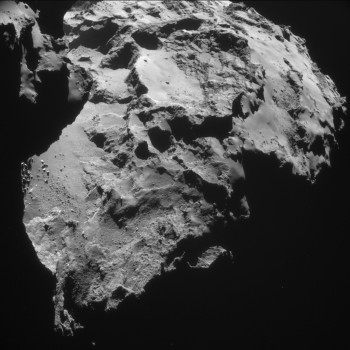








Discussion: 27 comments
Wooo very nice, thank you very much. hope Philae will be visible on this one 🙂
This sensation of a crumbling vessel at a forgotten yard.
Thank you Claudia for this exciting image. At last we can see some activity direct from the surface. In the main mosaic go to pixel 1200 x 1230 and there is a light coloured plume of gas and dust which looks like the smoke from a bonfire. I have created a couple of closer views in the two images below.
https://www.flickr.com/photos/124013840@N06/15697071534/
https://www.flickr.com/photos/124013840@N06/16133265469/
It is not a streamer or jet, but something is slowly outgassing either from, or a point very close to, that dark crescent shape.
It could just be an illusion of lighting and rock formations of course. I’ve looked back at some other images and now I’m not so sure. I would expect it to be straight, or cast a shadow.
Forgive me if this has already been addressed somewhere, haven’t seen anything about it personally. One thing I’ve been curious about that others can no doubt supply an immediate answer to is whether Rosetta has an onboard temperature gauge so that it’s reading can be compared to that of the comet surface temperature. In my layman’s mind, seems the two temperatures should be more or less equal, though the comet being black may cause variance. But if the two temperatures are significantly different, would be great to hear why, or at least the speculation.
Hi Sovereign,
I am a spacecraft thermal engineer myself so I can make an educated guess.
There are many “temperature gauges” i.e thermistors in a spacecraft. But these temperature readings are not uniform because of electronic units dissipations, sun illumination, thermal insulations, heaters, etc. Also, these temperature readings are a function of time since rosetta is orbiting the comet.
The same goes for the comet itself. Pending on the thermo optical properties of the surface, the sun illumination at a given time and the shadow casted by nearby cliffs or boulders, there is not one temperature of the comet but a temperature mapping.
As a conclusion, it is neither possible nor meaningful to compare Rosetta’s temperature to the comet’s temperature.
The MIRO instrument
“MIRO will sense the subsurface temperature of the comet nucleus to depths of several centimetres or more using the continuum channels at millimetre and submillimetre wavelengths.”
Sovereign – I’m sure they will have some internal monitors. But there wasis no reason to think they would read the same as 67P. A major aspect of spacecraft design is control of the internal temperature throughout the mission profile. A great deal of thought goes into controlling power dissipation, location, thermal conduction between parts, and emissivity of the spacecraft exterior. Some use internal heat pipes to move thermal energy around, thermally operated louvres to change emissivity, all sorts of tricks. The attitude may be controlled to control solar input by rotating the craft relative to the solar panels. I don’t know which of these methods Rosetta uses, but probably several.
So hopefully those ‘gauges’ are reading whatever the design value was for this phase of the mission.
67P long the other hand is whatever nature made it!
Thermally operated louvres are not used on european spacecrafts. I’ve seen some on NASA spacecrafts but I think it’s an “old” way to control the emissivity and doesn’t exist anymore.
For sure, heat pipes are used in Rosetta to conduct the heat of the electornic units to the radiators where optical solar reflectors (OSR) are dumping it to deep space.
Usually, the thermal subsystem doesn’t impose any constraint to the attitudes, orientation and control system (AOCS). AOCS has a lot on their hands already. It’s the other way around: Thermal subsystem will have to deal with whatever attitude is decided by AOCS. There is only one exception that I know of : when there is an important failure aboard the spacecraft, it goes into safemode. The safemode attitude is driven by thermal needs: you usually want to save power and expose batteries and computer to sun to keep them warm enough and to ease the burden on thermal management.
Many thanks, very informative.
Nice to know, Guili and Harvey, thank you for sharing your expertise.
I would be delighted if someone at ESA could tell us the spot in this image where the axis of rotation is — my guess is somewhere about one quarter of the way down from the top of frame D, and about one third from the left.
It fascinates me that there should be such a distinctive feature at the “pole” — I don’t have anything like enough science to guess at what that’s about,, but I am looking forward to reading about it sometime in the future when somebody with the tools to develop a good theory publishes it.
Look here at the video
https://blogs.esa.int/rosetta/2014/08/21/landing-site-selection-the-race-is-on/
Judy
I think that’s a very close guess. I presume you must’ve seen the ESA video linked previously to get it that close but if you haven’t, I’m impressed by your ability to get so close. The link is in the previous comment.
Here is a tweet showing a poster of the comet from a presentation at the American Astronomical Society meeting in January. The view is looking straight down the z axis of rotation and it’s going pretty well through where you say.
https://mobile.twitter.com/allplanets/status/545637097797730304
This picture shows the xy rotation plane which isn’t shown anywhere else:
https://scute1133site.files.wordpress.com/2015/01/img_2220.jpg
I have been using the model that is in that video; and thanks for the new links! those will be a lot of fun to study.
Judy
Judy
I think that’s a very close guess. I presume you must’ve seen the ESA video linked below to get it that close but if you haven’t, I’m impressed by your ability to get so close. Here’s the link if you haven’t seen it (scroll to see video):
https://blogs.esa.int/rosetta/2014/08/21/landing-site-selection-the-race-is-on/
Here is a tweet showing a poster of the comet from a presentation at the American Astronomical Society meeting in January. The view is looking straight down the z axis of rotation and it’s going pretty well through where you say.
https://mobile.twitter.com/allplanets/status/545637097797730304
This picture shows the xy rotation plane which isn’t shown anywhere else:
https://scute1133site.wordpress.com/
(The axis is off to the left in the picture. This site will have a post on the head feature you mention. It will be published in a few days’ time)
https://www.planetary.org/blogs/emily-lakdawalla/2014/08150814-finding-my-way-around-cg.html
The link above gives a great illustration of the axis of rotation, but its difficult if not impossible to accurately transcribe that to the image above. However, as the top of the two lobes faces the sun and the axis is through the neck (near centre?) I’d suggest it runs from 1 o’clock to 7 o’clock on the montage and is behind the head in frame D.
@Judy Hawkins–“where the axis of rotation is — my guess is somewhere about one quarter of the way down from the top of frame D, and about one third from the left.”
That is close to most people’s guess. I put it just below the large flat-bottomed “crater” ( Landing Site A, also called “The Ampitheatre”) on the “North Polar Plain”. We’ll need more info and bigger computers to locate the axis precisely, but that is where many people place it.
–Bill
Robin–
That dust streamer is a good example of Pareidolia. Nutters have been seeing Silverback Gorillas on Mars for decades for the same reason. 😉
https://en.wikipedia.org/wiki/Pareidolia
–Bill
I’ve been trying to find a value for the D/H ratio in the solar wind. Not obvious to me what it ‘should’ be, because you start from a low proto-solar value, but synthesise it in vast quantities, and then destroy it very fast…..,
I can’t find a direct observation.
But I found a number of assertions that the solar wind contains very few deuterons, mainly based on measurements on Lunar samples, for example
https://classic.rsta.royalsocietypublishing.org/content/285/1327/417.short
Is quite explicit., very little deuterium. And
https://classic.rsta.royalsocietypublishing.org/content/285/1327/417.short
Refers to the solar wind as a ‘pure proton beam’ in this context. But I’d like to find other data on it.
Now Rosina found a very high D/H value, three times the value in the earth’s water.
If ROSINA’s value does indeed differ strongly from the solar wind value, and that’s what I see so far, there is a bit of a problem for the water originating in the solar wind (on top of a stack of other problems of course.)
Ah, another, direct but preliminary result giving D/H ~10^-5
https://arxiv.org/pdf/0909.1279
But surely there must be better, more recent sources.
Sorry about the drip feed; remarkably difficult to filter out what’s wanted, lots of irrelevant hits.
But
https://www.lpi.usra.edu/meetings/lpsc2012/pdf/1709.pdf
Seems the most recent and definitive, and quotes an upper limit of D/H of 2*10^-7 from direct measurement on samples exposed to the solar wind.
The limit seems to have dropped steadily over time as methods improved
For comparison ROSINA found 5.3 +/- 0.7 *10^-4
I await explanations with interest.
Hi Prof,
there seems to have been no debate about how or why the D/H ration is so high or what that means for the comet, so its good to see someone interested enough to look further.
There is a lot of noise in those measurements though.
Deuterium is destroyed in stars, thus the solar wind contains very little.
Graham; yes I know, but sought direct confirmation of the solar wind value; stars also *make* it, so it’s not totally obvious how much would ‘escape’.
Dave, they quote +/-0.7 as the error bar ref 5.3 10^-5; it quite clearly does not extend down to 2*10^-7!
The explanation I’m waiting for – I’m quite sure one will be found – is how you could square that with the solar wind being the source of the water. But since posting this I’ve decided to disappear from that debate, see another post, its pointless.
I agree Harvey Its nothing like what was measured in the coma
I will look fwd to your results, it just that they they didn’t seem the most confident of papers I have ever read.
You may not have much luck with some of the posters here, but you have some very valuable things to say that I’m finding very much worth reading, although I don’t post much.
I hope you stick around!
Judy